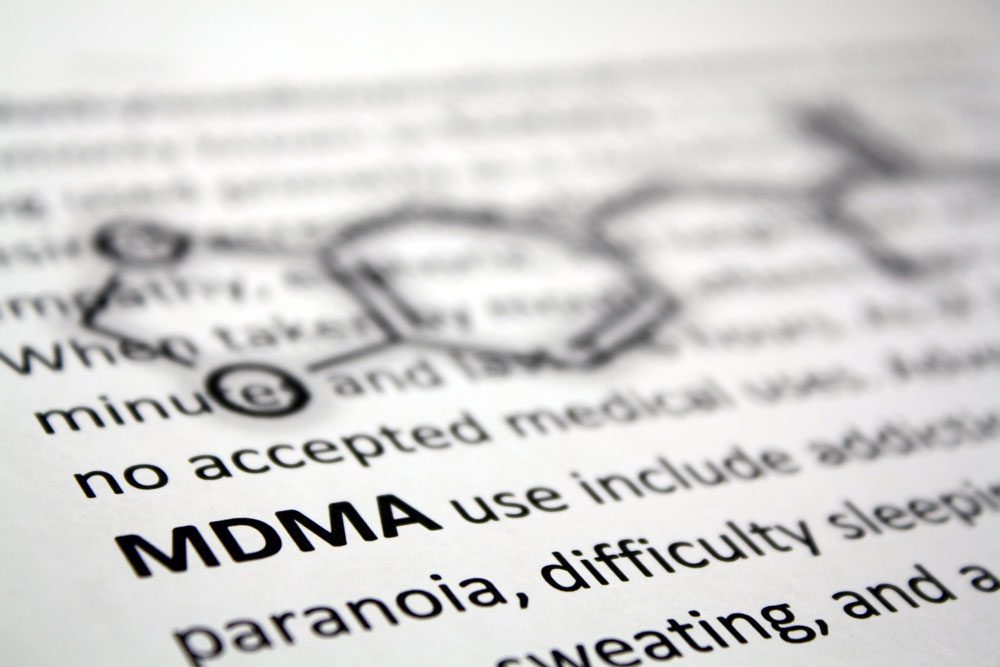Once the drug of choice at raves, nightclubs, parties, and concerts in the 1980s and 90s, ecstasy is making a comeback. Today, its growing popularity is among the rave generation, now aging adults in their 40s, 50, and older.
What is Ecstasy?
Commonly known as ecstasy, the name of the drug is 3,4- Methylenedioxymethamphetamine, or MDMA. It is a man-made, illegal drug that causes both stimulant and hallucinogenic effects. Ecstasy is the street name for the drug when it is in a tablet or pill form. It is called molly when it is a crystal-like substance or white powder.
Clarity, M&M, EX, E, Xtc, Beans, and MD are common street names for ecstasy. Other names include eckies, caps, pingers, dizzle, pills, and flippers.
How Does Ecstasy Affect the Brain?
Ecstasy affects three neurotransmitters in the brain: dopamine, norepinephrine, and serotonin. The drug increases their activity, particularly serotonin and norepinephrine. According to a report by the National Institute of Drug Abuse, serotonin plays an essential part in the body’s regulation of sleep, appetite, mood, and pain. Excess serotonin released by ecstasy elevates the user’s mood.
However, for several days after taking ecstasy, many people experience negative psychological effects caused by depleted serotonin levels. They often have memory problems, feel confused, and experience anxiety, depression, and paranoia.
The report also explains that PET scans of brains of people who have stopped using ecstasy show decreased brain activity in regions that involve sensory and motor function, memory, learning, and the formation and processing of emotions.
How Does Ecstasy Make You Feel?
When a person takes ecstasy, they typically get a feeling of overall well-being, friendliness, and happiness. They feel relaxed and calm. Their senses of smell, sound, sight, touch, and taste are enhanced, and their sense proprioception is heightened. Several additional effects of ecstasy include:
- Feeling of euphoria
- Lowered inhibitions
- Increased extroversion
- Long-lasting energy
- Increased emotional warmth and empathy for others
- A willingness to talk about memories that are emotionally charged
The Resurgence of Ecstasy and “Brieing”
No one is really sure why middle-age people in the United States and around the world are turning to ecstasy–or returning to it. It’s also possible that they never stopped using it. Many believe the surge in use is due to former ravers from Generation X, born between 1964 and 1981, who are refusing to grow old.
Ecstasy is the new drug of choice for some middle-aged women at dinner parties where “brieing” has grown popular. This strange trend, which is spreading around the globe, began in London. A 50-year old businesswoman explained to her interviewer that she regularly hosts dinner parties fueled by ecstasy. She stuffs ecstasy in brie cheese and serves it to her guests.
The Dangers of Ecstasy
Although fatal doses of ecstasy are uncommon, the drug can cause adverse health effects that can be life-threatening, such as hyperthermia, loss of consciousness, kidney failure, seizures, and swelling of the brain. Heart damage or disease, high blood pressure, memory impairment, inability to pay attention, and decreased cognitive function are also common dangers of ecstasy use.
Less severe adverse health effects include:
- Disorganized or illogical thoughts
- Chills or hot flashes
- Involuntary teeth-grinding or jaw-clenching
- Mood changes, irritability, aggression, anxiety, and depression
- Panic attacks
For hours after taking ecstasy, the user’s ability to perceive and predict motion is greatly reduced. For example, if the person was driving a car, they would not be able to judge if they were going to collide with another vehicle. They are unable to perform skilled or complex activities during that time. Individuals are also more likely to engage in risky sexual behaviors, such as engaging in sex with multiple partners or without using a condom.
If You Need Help
If you or a loved one is struggling with a drug or alcohol addiction, now is the time to get help. You are not alone. At Canyon Vista Recovery Center located in Mesa, Arizona, our caring team of professionals will guide you on your journey toward living a clean and sober life. We use a combination of evidence-based addiction treatments, psychiatric care, and holistic therapies to provide you with the skills you need for a long-term successful recovery. Give us a call and take the first step on your road to recovery.





